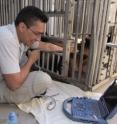National Zoo giant panda pregnancy update
Related images
(click to enlarge)
Scientists at the Smithsonian's National Zoo detected a secondary rise in urinary progestin levels in the Zoo's female giant panda Mei Xiang (may-SHONG) earlier this month. The results from the test on Thursday, June 19 lead scientists to believe the hormone rise indicates that it would be mid- to late-July before Mei Xiang either gives birth to a cub or comes to the end of a pseudopregnancy, or false pregnancy, which is common in giant pandas. Zoo scientists artificially inseminated Mei Xiang with semen from the Zoo's male giant panda Tian Tian (t-YEN t-YEN) March 19. Since then, scientists have conducted weekly hormonal analyses on daily urine samples from Mei Xiang. Zoo veterinarians are conducting weekly ultrasounds on Mei Xiang to monitor any changes in her reproductive tract and look for evidence of a fetus. So far, they have not seen evidence of one.
Because panda fetuses do not start developing until the last weeks of a gestation period, Zoo veterinarians say they do not yet expect to see a fetus. They stress, however, that it is still too early to determine if Mei Xiang is actually pregnant or experiencing a pseudopregnancy.
In 2005, in the last weeks leading up to the birth of Mei Xiang's only cub Tai Shan, she would not cooperate for her weekly ultrasounds and it was not possible to definitively determine if she was pregnant.
This is the sixth year the National Zoo has tried to breed the giant pandas; Mei Xiang had pseudopregnancies in 2002, 2003, 2004 and 2007. She gave birth to Tai Shan in 2005 and did not reproduce in 2006. Mei Xiang, 8 years old, and Tian Tian, 9 years old, live at the Fujifilm Giant Panda Habitat at the National Zoo.
Source: Smithsonian
Other sources
- National Zoo giant panda pregnancy updatefrom Biology News NetFri, 20 Jun 2008, 20:07:14 UTC
- National Zoo's panda might be pregnantfrom MSNBC: ScienceFri, 20 Jun 2008, 15:35:21 UTC


